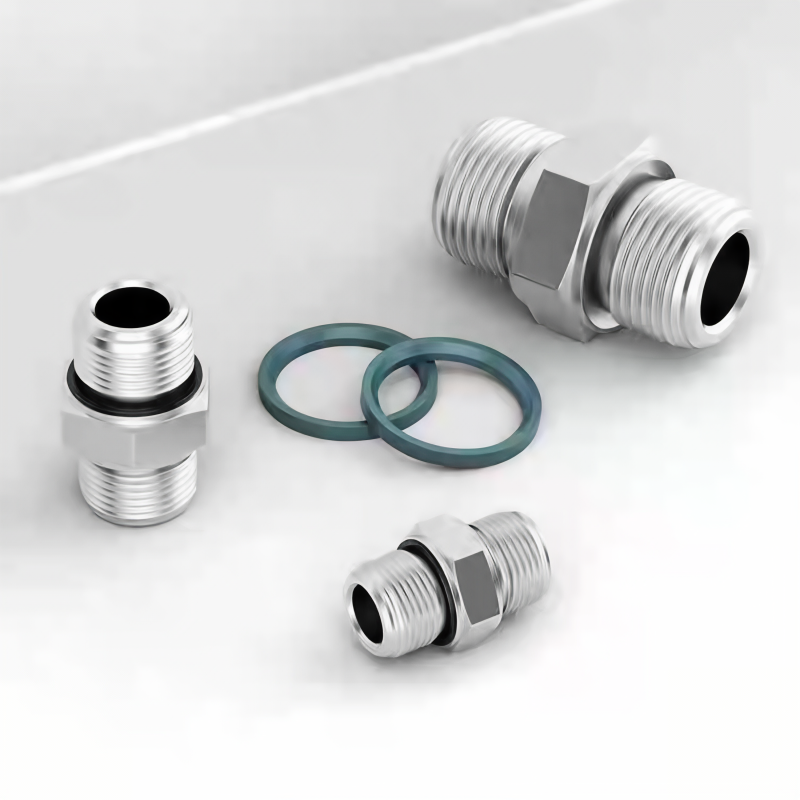-
The common hydraulic hose standards are as follows: International standardsISO standards: Standards formulated by the International Organization for Standardization, widely recognized globally. For example, ISO 1436 stipulates the relevant requirements for steel wire braided hydraulic hoses, and ISO 3862 stipulates the relevant requirements for steel wire wound hydraulic hoses.SAE standards: Standards formulated by the Society of Automotive Engineers of the United States, widely used in North America. For instance, SAE J517 stipulates the technical requirements such as size and pressure rating of hydraulic hoses.DIN standards: Standards formulated by the German Institute for Standardization, commonly used in Europe. For example, DIN EN 853 and DIN EN 856, DIN EN 853 stipulates the relevant requirements for steel wire braided hy...
-
Whether it is high-pressure hydraulic systems, high-temperature pipelines, or food-grade equipment and medical instruments, [Company Name]'s rubber sealing products can always be precisely matched. Currently, our core product line includes:O-ring seals: ranging from 1mm diameter micro-components to 300mm large components, covering 12 materials such as nitrile rubber (NBR), fluororubber (FKM), and silicone rubber (VMQ), suitable for working environments from -60℃ to 260℃, meeting the static/dynamic sealing requirements of hydraulic and pneumatic systems.Combined sealing components: such as Gland rings, Strobel rings, and Trapezoidal rings, using a "rubber + metal/PTFE" composite structure, still maintaining excellent sealing performance under high pressure (up to 60MPa) conditions, widely used in heavy equipment such as construction machinery and injection moldin...
-
In the high-temperature environment of summer, the rubber workshop is prone to form a high-temperature and high-humidity environment due to factors such as heat generated by equipment operation, the characteristics of raw materials (such as rubber and vulcanizing agents), and the confined space. This not only affects the comfort of workers but may also cause equipment failure or safety hazards. The following are targeted summer cooling plans and precautions:I. Practical Solutions for Cooling Off in Workshops1. Hardware facility upgradeForced ventilation and air exchangeInstall high-power industrial exhaust fans (at least one for every 50 square meters) on the top or side walls of the workshop, and work in conjunction with negative pressure fans to create air convection, expelling hot air and introducing fresh outdoor air. In high-temperature areas (such as around the vulcani...
-
In the field of industrial piping, connecting pipes of different diameters is often a key challenge in engineering. ED reducing adapters, with their innovative design and excellent performance, have become the ideal solution to this problem. Analysis of Core Advantages Precise Adaptation, Flexible ConversionED reducing adapters support various pipe diameter combinations (e.g., DN15-DN150), enabling seamless connection of pipes of different sizes and achieving a smooth transition of fluid paths. Both concentric and eccentric structural designs can reduce pressure loss and ensure efficient operation of the system. Reliable Material, Corrosion ResistanceMade of high-quality materials such as 316L stainless steel, they pass the salt spray test (no rust for 240 hours) and are suitable for high-corrosion environments such as chemical industry and mar...
-
Still worried about sealing the equipment holes and preventing dust and leakage? Our company's newly launched rubber hole stoppers are here! Selected high-elasticity nitrile rubber, resistant to aging and corrosion, remains stable as a mountain in an environment ranging from -30℃ to 120℃. From φ5mm to φ50mm, 12 specifications are fully covered. Precision molds are formed in one piece, and they fit tightly into the holes without loosening or bulging.Whether it's the reserved holes of mechanical machine tools, the process holes of household appliance shells, or even the temporary sealing after pipeline maintenance, it can handle them all. The eco-friendly material has no odor and can be used with confidence in food-grade scenarios....
-
Silicone rubber, a polymer material with Si-O bonds at its core, is reshaping multiple fields with its unique properties. It can withstand extreme temperatures ranging from -60 ℃ to 250℃, and features electrical insulation and anti-aging properties, making it the preferred choice for battery packaging in new energy vehicles and sealing of photovoltaic modules. In the medical field, medical-grade silicone rubber supports the innovation of implantable devices with its biocompatibility, while liquid silicone rubber, through 3D printing technology, is achieving precise manufacturing of complex structures.Industry data shows that the market size of silicone rubber in China is expected to reach 34 billion yuan in 2025, with an average annual growth rate of over 15% in demand in fields such as new energy vehicles and 5G communications. It is worth noting that degradable silicone rub...
-
I. Preparations and Inspections Before Installation1. Specification and compatibility confirmationCheck the nominal diameter, working pressure, temperature range and medium compatibility of the hose (such as whether it is resistant to oil, acid, alkali or gas, etc.) to avoid hose aging or cracking due to medium corrosion (for example: nitrile rubber is oil-resistant, ethylene propylene diene monomer rubber is ozone-resistant and high-temperature resistant).Confirm the usage scenarios (such as industrial pipelines, gas transmission, automotive fuel lines, etc.), and select hoses that comply with industry standards (for example, gas hoses need to conform to national standards such as GB 29993).2. Appearance and quality inspectionCheck whether there are cracks, bubbles, scratches, aging, hardening or softening on the surface of the hose, and whether the interface (such as the cr...
NEWS & EVENTS
Specializing in the production of mechanical equipment and vehicle necessary for the functional customization of rubber, plastic, CNC processing, filter press accessories and other products.
News Center


















